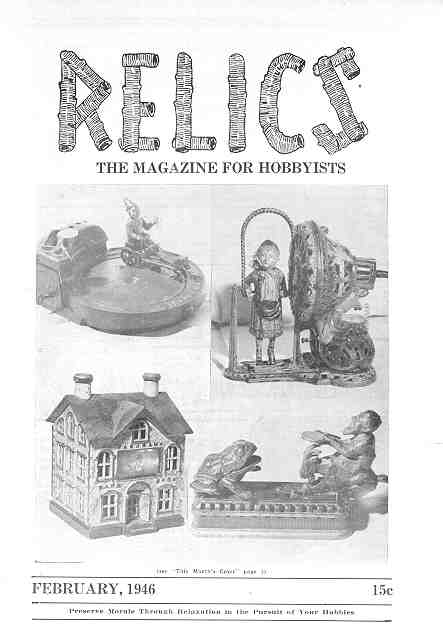The Old Toy Shop
By Louis H. Hertz — RELICS Magazine — February, 1946
MECHANICAL BANKS, Part 1

Repeated requests express a desire that we devote some space to a discussion of mechanical banks, and we shall undertake to comply in this and the immediately following issues of "Relics." The pictures of banks which will be employed to illustrate some of the following articles are used through the courtesy of W. F. Ferguson. We should also like to express our appreciation to Mark Haber, who has done much to facilitate our research on this subject.
As the advertising columns of this department indicate, there is a great deal of interest in mechanical banks, which, due to several factors, have taken a leading position in toy collecting. It seems obvious that this interest will continue to expand and grow as time goes on, for there are always new enthusiasts seeking knowledge of the subject.
The name "mechanical banks" is really a misnomer for in toys "mechanical means clockwork, yet only a handful of the so-called mechanical banks are activated by clockwork mechanisms. However, the name is so widely applied now that it is unlikely a more descriptive term will be employed in place of it.
Mechanical banks are banks in which some movement of a figure or object causes, accompanies, or follows the depositing of a coin. "Still" banks are, of course, banks in which a coin is simply dropped into a slot, without any action or animation. There are a few banks which are borderline cases, the mail box banks, for example, in which the lid of the box is opened to drop in a coin, seemingly might fall within the limits of the definition of a mechanical bank, but it is universally considered a still. On the other hand, there are a few banks which are generally regarded as mechanicals, or "semi-mechanicals" which might better have been left out of the group, such as the so-called "semi-mechanical Merry-Go-Round." This bank is entirely different from the much older and more elaborate Merry-Go-Round bank (pictured on cover) in which the horses go around when a coin is inserted, and which is most definitely a true mechanical. The semi-mechanical bank of the same name is mounted on a pivot so that merry-go-round may be turned by hand, but the coin is simply dropped into a plain slot, like any ordinary still bank.
One bank which is frequently incorrectly mentioned as a mechanical but which is quite definitely an ordinary, if rather elaborate and unusual, still bank is the bank which portrays General Benjamin Butler as a big green-backed frog, clutching a wad of greenbacks. The frog’s head is a perfect reproduction of the General’s. This bank caricature presumably dates from 1884 when Butler ran for President on the Greenback-Labor and Anti-Monopolist ticket.
President Theodore Roosevelt was caricatured in an actual mechanical bank, known as Teddy and the Bear, in which he was portrayed hunting a bear and firing the coin from his gun. This bank was so popular that enormous quantities of it were made and sold up until a fairly recent date. A second bank caricaturing the illustrious Teddy, the Lion Hunter, proved far less popular and, as a result is less often found today.
Before describing further individual mechanical banks, we should, however, complete the outline of the various groups into which toy banks are now generally divided. In addition to the mechanicals and stills, there is a third group, registering banks, which falls somewhere between the other two in general interest, although many of them have far more complicated and ingenious internal mechanisms than most mechanicals.
Registering banks, of course, are banks which automatically add up the sum of the coins deposited, and reveal at a glance at the figures, just how much money is in the bank. There are a few borderline cases here, too, but most of the registering banks fall quite readily into their own special classification.
The mechanical banks most often feature figures of animals or persons who move or perform some action — take the coin in hand, shoot it from a gun, throw it into a slot, play baseball, move around a track, pop out of concealment, etc. Generally action may be motivated by releasing a simple tension spring or hand lever. There are no strict bounds, and the range of designs is so wide that it is difficult to cover the subject broadly in a brief statement. The illustrations this month and those that will appear in the following issues provide some idea of the wide range of ideas and designs which occur in mechanical banks.
It is hard to say exactly how many different mechanical banks were made in all, as there are many major and minor varieties, and it is often difficult to determine just what constitutes a specific bank type. There are probably about 250 different major types of mechanical banks known to have been made in the period from around 1868 up to the start of World War II, although, of course, only a comparatively few late types were made in recent years. Very occasionally now, a new and hitherto unknown type of mechanical bank will turn up to be added to the check lists.
Most of the mechanical banks were made of cast iron, and the vast majority were manufactured in this country. There were also a few mechanical banks made of, or incorporating wood, stamped metal, or white metal alloys. Some iron banks were made in England and Canada, largely closely following designs originated in this country, and some cheap lithographed banks were made on the European continent, as were a few in this country.
This has, of course, been by the way of an introduction to a very broad subject, and we shall endeavor to go into some more detailed aspects of that subject in the next two issues.
